There’s always a first time, and that goes with campervans too!
In 2021 we converted a van and started traveling the world full-time in 2022: we didn’t know much about living on a camper!
We jumped into this new adventure full of enthusiasm, but of course we were not fully prepared for it (can someone ever be fully prepared? We think not! 😛 ).
In over two years on the road full-time, we made dozens and dozens of mistakes, minor ones, silly ones, and gigantic ones too!
In this article, we thought of making a list of the most stupid mistakes we made while traveling with our campervan, and leave you precious tips from our experience so you won’t fall in our same pitfalls!
Let’s dive right in!
Mistake 1:
Not Knowing your Vehicle!
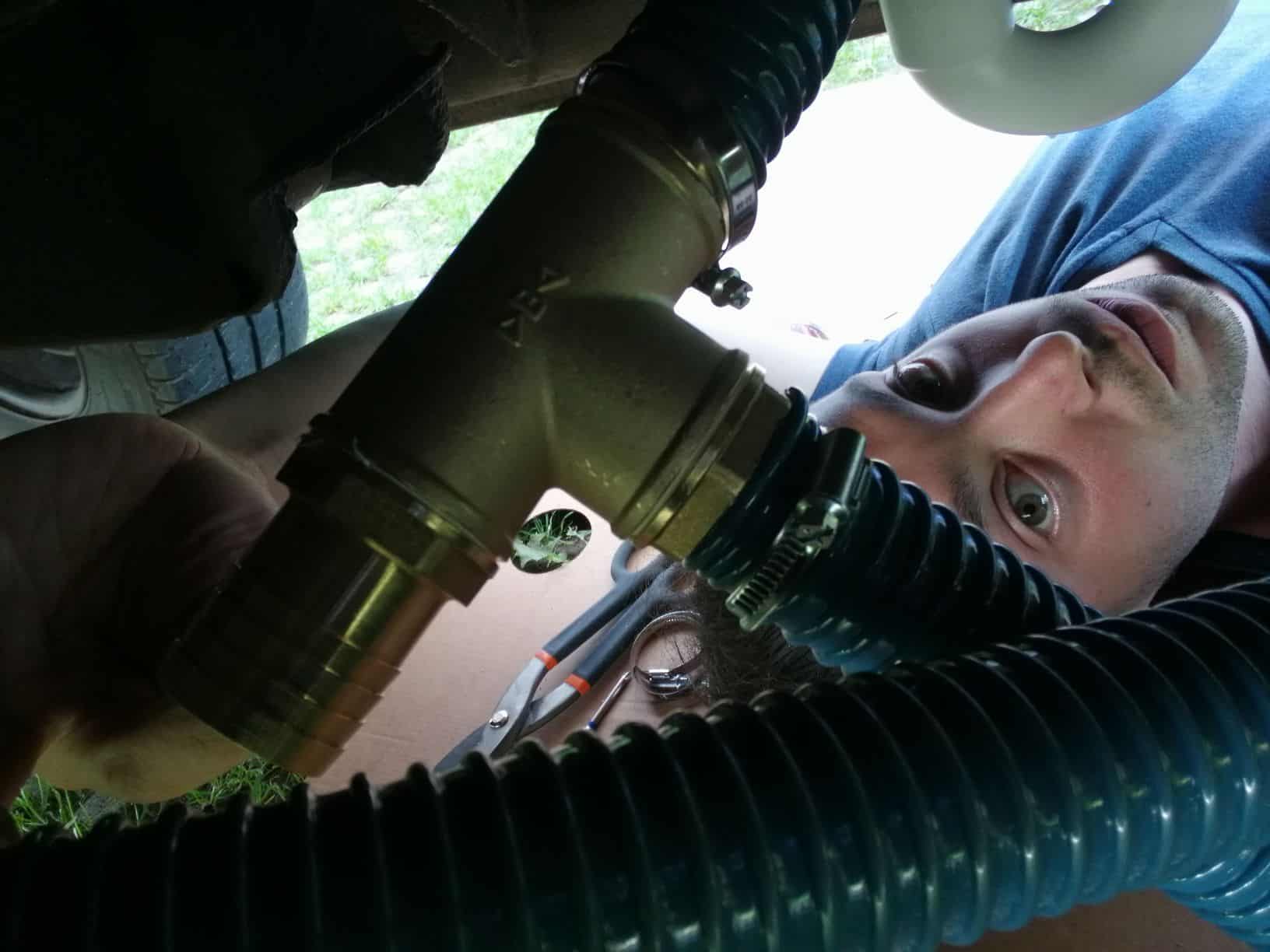
We always loved improvising our route on the go, and we don’t usually plan our itinerary too strictly: that’s the fun of being on an adventure right? 😉
Said that, on the road we realized that a successful campervan trip begins long before you put the key in the ignition: it starts from knowing your own vehicle!
We built our vehicle ourselves, so for the living part I know how it works inside out: electrical system, hydraulic system, heating, solar panels… in case of problems, I know where to put my hands!
Less I knew about how the engine and the “mechanical” side of the vehicle and all the warning lights that can switch-on on the driver’s screen.
NIGHTMARE ONE: BRAKES PROBLEM IN CAPPADOCIA!
Once, we had the brake light turning red on our first night in Cappadocia: we reached the top of a horrible dirt road.
It was truly borderline for our van: very steep, without places to turn back, and holes in the road 50cm high.
We arrived there by night, once on top, the brake warning light rings and turns red: panic!
We didn’t have internet signal, we didn’t know where we were, we could not see a thing, we were tired after 4 hours driving from Ankara…and just now this new problem!
After thinking it over and over, we decided to descend once again the hill using the handbrake, as slow as possible.
The day after would have been even more dangerous if some vehicle were to come up that same road!
Useless to say, I was scared as fuck, I was imagining the brakes breaking at any moment…
Once down, after a deep breath, we drove to nearest city (25km away) at 20km/h, while trying to never use the brakes.
The morning after, the mechanic explained us that the problem was the brake oil, that went slightly under the lower limit (but like one millimeter down!). No need to hurry too much, he added the liquid, and the warning light went off.
Knowing what it was, I wouldn’t have drove so slow and so scared all the night before! We were panicking, seriously! 🙂
NIGHTMARE TWO: TOO MUCH OIL IN PORTUGAL!
Another time we were traveling in Portugal and the oil warning light came on.
No big deal, I thought, just need to add some more oil.
By chance, we stopped near a Norauto workshop, so I decided to go buy some oil.
I explained to the clerk about the red oil light, and he sold me 5 liters of oil, telling me to add that. I did, and we set off.
After about 50km, another warning light that I had never seen before came on, I was pretty surprised!
Looking up its meaning online, I found out it indicated “too much oil” and the only solution was to remove some or the engine would have failed…What happened next?
We had to stop at the first workshop to remove the excess oil I had added.
When I explained to the mechanic what happened, he gave me a perplexed look: “5 liters?!! You’re crazy? You only supposed to add a maximum of one!“.
Well, I didn’t know that, and I had messed up big time!
It cost us 50 euros (for the oil purchased) plus 50 euros for the service, 100 euros in total…
After this blunder, I studied all the dashboard warning lights and their meanings 🙂
TIPS TO AVOID OUR MISTAKES:
A campervan is not a car nor a house, it’s a 2 in 1, and when we say you need to “know your vehicle”, we mean both the mechanical part (at least the basics!), and the living part (and all its systems and limits).
Before a campervan trip, we would recommend you to get acquainted with:
- Electrical System: know how many watt/hour of service batteries you have (Ah x 13V), and understand what you cannot power, what you can power and for how long. In this way, you can boost the longevity of your system while avoiding to remain without electricity when you most need it!
- Hydraulic System: know how many liters you can fill your tanks, know where the pipes are passing, what to do in case of freezing, how to empty the system in case of emergency etc.
- Heating: heating in winter is vital. Be sure to know well your heater, all settings, and if problems arise, be sure to have a second option (can be a second different heater, a 12V blanket, or just accepting going to a hotel for a night…)
- Safety Measures and Anti-Theft: know the anti-theft systems you’ve got installed (check the full guide here!) and how to set them up properly!
- Mechanical Basics: Learn what the different warning lights mean and what to do in case of emergency. Some of them are less problematic than others and can be solved DIY (ex. changing a fused light bulb!), while others require the immediate attention of a professional. Read your camper’s instruction once, and you’ll get the peace of mind of knowing at least what’s going on!
- Know your vehicle’s fluids: Wipescreen fluid, AdBlue, Oil, Fuel, Brake fluid… know where all those fluids are and be sure to check their level if you’re planning a long trip!
- Ideal Tyres Pressure: the front wheel of a campervan need less pressure than the back ones (which need to withstand more weight!). In the same fashion, the tyre pressure should be adjusted when your vehicle is empty or fully-loaded. In most vehicles there’s a label around the driver seat where it’s written the ideal tyre pressure depending on the vehicle weight. Check it out and be sure to keep the pressure in check (one of our wheels exploded once!).
Mistake 2:
Ignoring the Weather Forecast
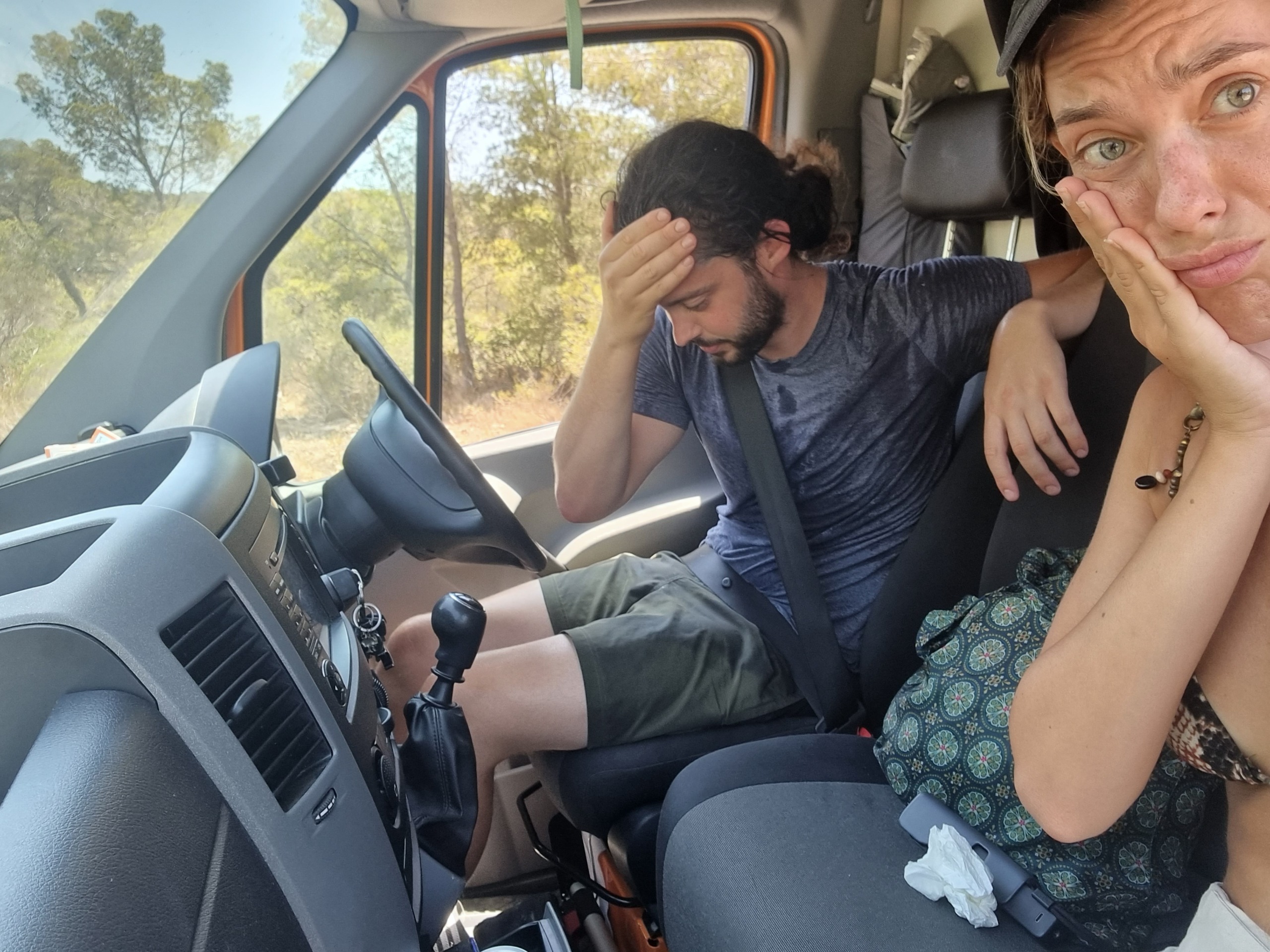
After becoming aware of how your vehicle functions, the second wise thing to do is to plan your destinations based on the weather.
Yes, because depending on the insulation of your vehicle, your battery bank, heating, or the presence or absence of an air conditioner or an awning, traveling to hot places in summer or cold places in winter can be an enjoyable and feasible experience, or an authentic torment.
Underestimating weather conditions can turn out to be really problematic…and we learned that the hard way!
NIGHTMARE ONE: THE SCORCHING HEAT OF MALLORCA IN JULY!
Both Isa and I adore the Spanish island of Mallorca. It’s the island where we met and the island we both call our “special place.”
As the first destination of our full-time itinerary, we thought of going to Mallorca, exploring it far and wide, and filming all its beaches.
What a great plan, you might say!
And indeed, the island was beautiful!!! Too bad we arrived on July 15th!
Without air conditioning, with days reaching up to 40°C… it was unbearable to stay in the van, and working on the computer was truly impossible!
Moreover, we had to leave the van in the sun to charge with the solar panels, which at too high temperatures overheat and charge at 60% of what they could at normal temperatures. Well… a nightmare!
Yes, we spent a month traveling around the island which, thinking about it now, was epic, but… how we sweated!
Seriously: how we sweated!!!
We would wake up in the morning, and we were sweating.
From 8:30 in the morning, the van was already an oven!
We practically ran to the beach every day to throw ourselves into the water and take advantage of the cold showers in public bathrooms.
We visited the whole island, it was beautiful…but also a huge ordeal!
Having done it in spring or autumn, we would have definitely enjoyed it more!
NIGHTMARE TWO: SANDSTORM IN MONOPOLI BY THE SEA
Another time, we were in Monopoli in Southern Italy and stopped at a secluded spot on sandy ground near the sea.
It was a place we had already visited with friends and had really liked, so we decided to come back.
We parked, opened the awning, pulled out the table and chairs, and I was already planning a workday on my laptop by the sea. Within 20 minutes, an incredible wind picked up!
The sand was very fine and began to fly everywhere: into the van, onto the bed, between the keys of the laptop, on us… in 10 minutes, we were covered with a layer of sand everywhere, we even had sand between our teeth!
There was no way around it: we had to close everything up quickly and move to another place without sand… had we checked the weather forecast beforehand, we could have easily avoided it!
TIPS TO AVOID OUR MISTAKES:
Check the weather before you go.
This is the most obvious tip, yet the most useful, seriously!
Bad weather isn’t just uncomfortable; it can also be dangerous.
Keep an eye on forecasts for your route and destinations and especially for:
- Heavy rains: Can lead to flooding and closed roads. Rains could also transform trails into torrents, and turn soil into sticky mud. Biking under the rain is of course not as nice, and camping outdoor becomes off-limits.
- High winds: Might make driving unsafe as campervans have a large surface and can be pushed easily (it’s actually pretty scary!). Wind can also make camping incredibly un-cozy, especially combined with dry/sandy parking spots. Once, we were on the beach of Monopoli (an southern-Italian city, not the board game!), and we had to move because of the sandstorm we found ourselves into! Pretty annoying…
- Extreme temperatures: too high temperatures might overheat the engine, they cause the solar panels to produce less energy, and they turn your camper into a oven! On the other side, too cold temperatures might freeze your water system, freeze the diesel if it’s extreme cold, and lithium batteries won’t charge under -0°.
- Hailing: this is the nightmare of any driver, and for camper drivers even more! Crossing path with a summer hail can destroy solar panels, windows and damage your entire vehicle car body. If there’s risk of hail in the air, find a safe covered spot as soon as possible, or even better, drive away from the danger zone.
- Snow: to navigate snow, you need at least the basic equipment: snow chains and snow wheels. If your vehicle is not prepared, it’s better to avoid risking it!
Remember also that your phone’s weather app is your road-trip sidekick—it clues you in on whether you need to pack that extra sweater or not.
Cold temperatures demand layers, thermal wear, and warm hats, while sunny skies call for lighter materials.
Always pack rain gear, because you never know when you’ll run into a surprise shower!
Last but not least, just because it’s outdoorsy doesn’t mean your skin’s ready for full-on sun exposure, so always slap on some sunscreen, even on cloudy days.
Opt for at least SPF 30 and apply it 30 minutes before heading out! 🙂
Mistake 3:
Forgetting to consider Bugs
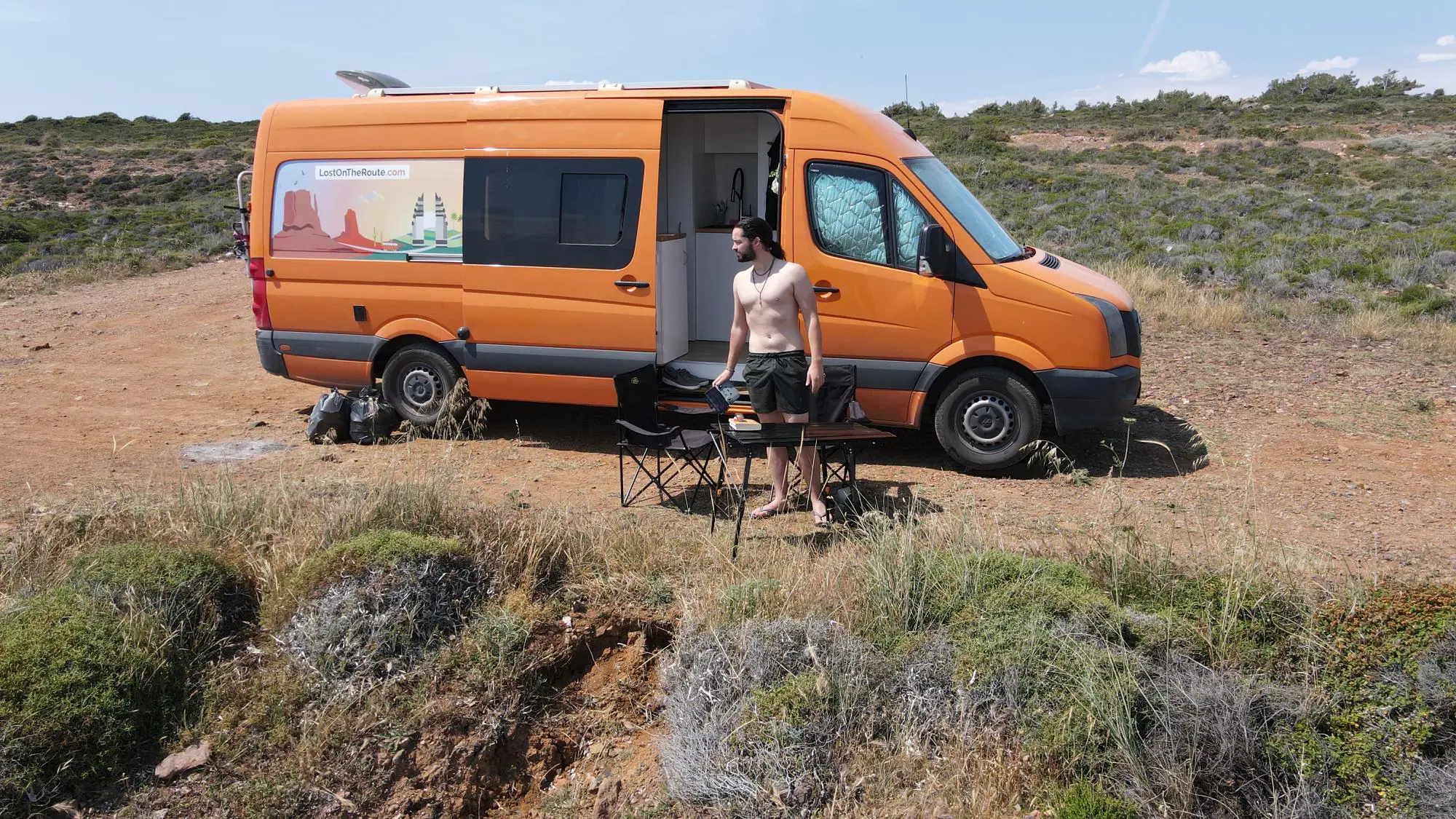
OUR EXPERIENCE
Spring and summer are the favourite seasons of many van travelers, but so are also for bugs!
When we started traveling full-time with our campervan, we did not have any mosquito net: not on the doors, not on the windows.
Occasional flies sure are annoying, but they don’t bug me much. Isa though, she can’t stand any insect!
So, during the good season, when we were parking in places with flies, I got into the routine of spending 10 minutes a day before closing the van, killing them all (yeah, it was brutal, I called it “splatter time”!).
Annoying, but helped me also to make some gymnastic. After a while I got tired though, and I invested in an electric mosquito scoop to make it faster!
We managed to survive a surprising one year and half without nets!
THEN IT HAPPENED: A BUGS ATTACK IN TURKEY!
One evening in May, we found a parking spot in the middle of nowhere on the west coast of Turkey.
A secluded little place, yes on the sand, but well-trodden.
No one around: a paradise basically!
We decided to stay there the whole next day and enjoy the beach.
Then, around noon, after an enjoyable morning by the sea, I went up from the beach to grab a snack and a couple of cold beers.
I open the door of the van and before I even had time to open it fully: zaaaam! A huge swarm of little bugs flew in!
SOME TIPS FROM OUR EXPERIENCE:
- Check where you park: it seems silly obvious, but we happened to park on a ants nest and we had ants walking up our wheels and somehow into the cab! Another time we parked near a wasp nest and had to move fast!
- Distance Dining: Don’t crumble food near your vehicle when you make pic-nics, so you will avoid ants.
- Cleanliness is Key: Keep your site clean. Wipe down surfaces and properly dispose of garbage to avoid attracting animals.
- Stock up on Repellent: never go on a campervan trip without repellent! We learned it the hard way, and now learned from our mistake, we always have at least two bottles of extreme repellent in our van!
- Get a anti-mosquito machine: mosquitos love Isa (and they never bite me!), so we had to find a solution for her! We found this anti-mosquito accessory that lasts us up to 30 days with one recharge. We switch it on in summer few hours before sleeping to kill any mosquito in the van, and with two-three recharges we can easily do all the good season.
- Install Bug Barriers: Who said that bug barriers cannot be aestethic too. Initially, we didn’t install nets on our van because we didn’t like the “closing” feeling of mosquito nets. Then our misadventure in Turkey happened, and we reconsidered. Actually, mosquito nets add a soft layer privacy to the inside, while allowing us to keep the doors open in summer…we should have done it much sooner!! 🙂
- Back-up Plan: For us, that means keeping in our van a powerful multi-insect spray to deal with any insect attack it might happen on our journeys. Once was enough, and we will make sure it’ll never happen again!
Mistake 4:
Forgetting Essential Gear
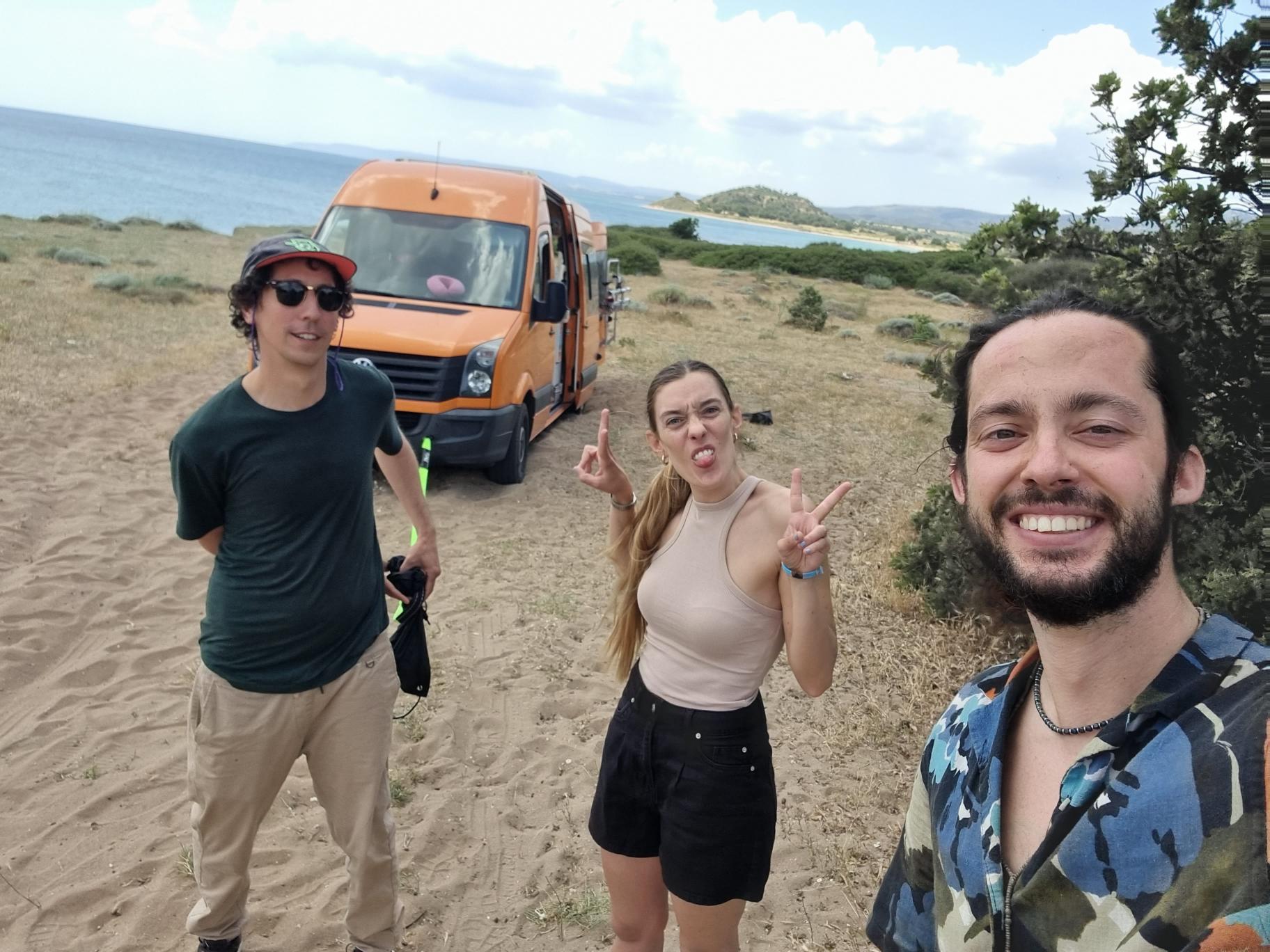
When traveling with a campervan, being prepared for the unexpected is essential.
We’ve already seen that knowing how our vehicles work is essential, and so it’s checking the weather forecast of the destinations we are planning to reach.
Going a step beyond what we’ve already seen, it’s definitely crucial to make sure you have the right accessories to handle emergencies.
Chains or studded tires for the snow, antifreeze for the winter, a spare tire and kit to change it, an extension cord for electricity, etc.
Obviously, some things are easier to think of than others, and experience definitely plays a key role.
But let’s continue with the story of our previous nightmare! ;D
OUR NIGHTMARE CONTINUED AFTER THE BUGS, AND IT GOT WORSE:
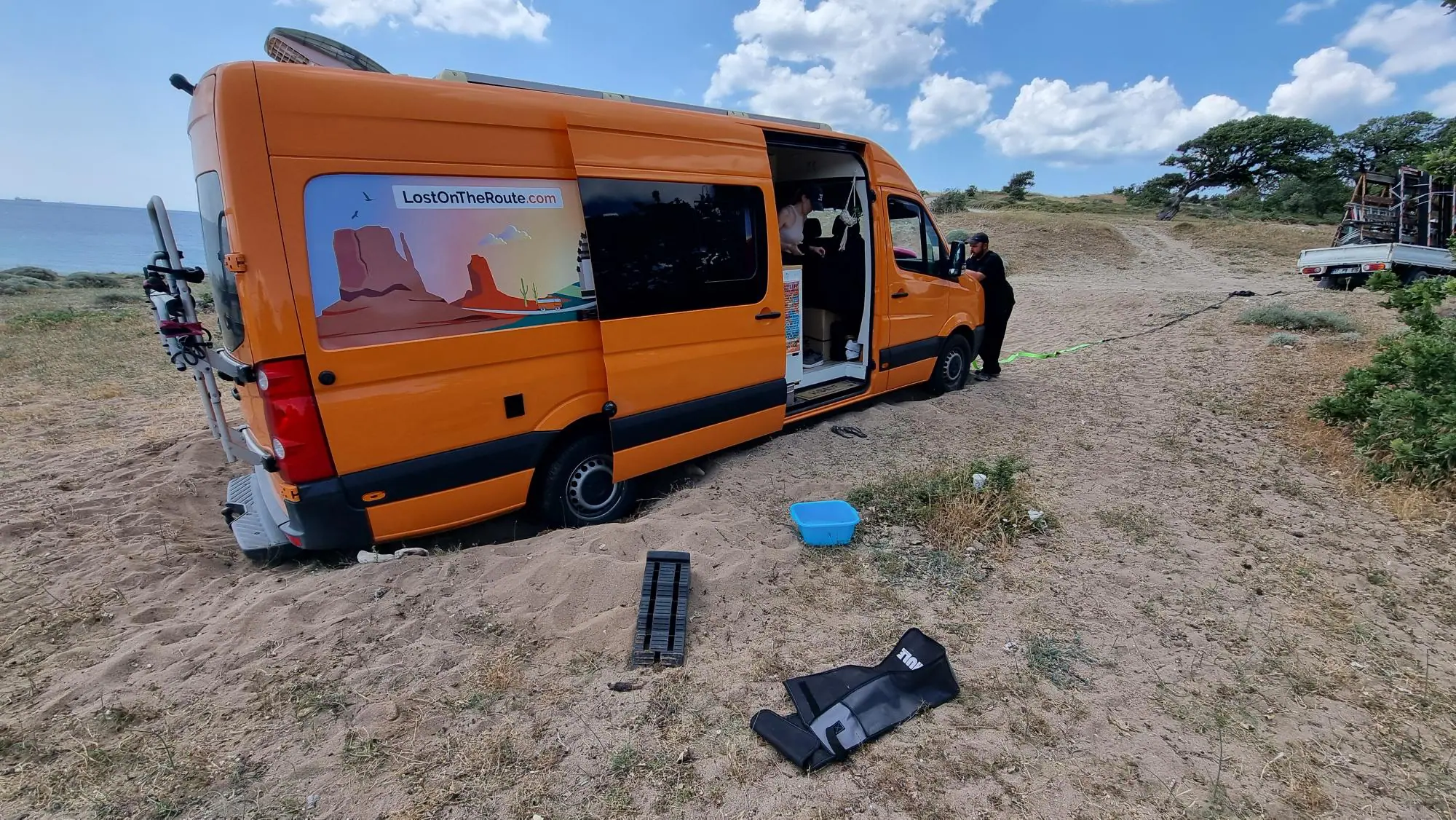
Still at the same beach from before.
We closed the van, started the engine, and made to leave.
We turned the van, drove 15 meters, and then… the van wouldn’t move: neither forward nor backward. No…we couldn’t believe it!
We were full of insects, stuck in the sand, under the sun with 30°C outside, and in Turkey!
The more I dug with my hands to remove the sand, the more the van sank; there was no way to get it out, neither with wood under the wheels nor with stones…it just kept sinking deeper!
While we were being eaten by insects and drowning in sand, fortunately, a minivan with a French couple passed by, who lent us a tow rope and a portable (but very sturdy) shovel.
With these accessories, and the help of a tractor passing by, we managed to get out of the sand at no cost.
Yes, full of bug bites, sunburnt, covered in sand, and sweating like crazy…but we made it out!
Without the tow rope, we would have had to call a tow truck and pay 250 Euros (crazy in Turkey!).
Lesson learned, as soon as we got back on our feet, we directly bought our own rescue kit!
TIPS TO AVOID OUR MISTAKES!
Think the unexpected, and get the right gear to navigate difficult situations.
This is what we currently have on board, and what we recommend having on board if you’re travelling for long periods of time (but also for short trips!):
- Snow chains: for snowy roads
- Wedges: to park comfortably also where the ground is not flat
- Towing Rope: for when you get stuck (and happens to everyone!), if you find the help of a larger vehicle, you might get our for free!
- Metal Shovel: for snow, for mud, for sand, for pic-nics… having a foldable and sturdy shovel reveals more useful than what we thought 🙂
- Telescopic Ladder: to climb to the van roof for maintenance
- Spare Wheel and Mounting Kit: we changed two wheels in a year, once in Croatia and once in Spain. Having all we need to change it on our own saved us hassles and money. And we are also so fast now changing it!
- Emergency Triangle and Yellow vest: in case you need to stop on a dangerous road, it’s important to signal your presence!
- Jumper Cables: to jump-start your batteries when they are dead. We got a pair 5 meter long, so we can reach our engine battery from our service batteries and, in case we forget some lights on all night (happened more than once!), we can jump-start ourselves with our own service batteries, without the need of another car.
- AdBlue: most recent diesel vehicles use AdBlue to reduce emissions. You need to tank AdBlue once every 8-10.000 kilometers, so it’s not something to do everyday, but if you run out of AdBlue your vehicle will stop! If you plan long trips out of Europe, where AdBlue is less common, be sure to bring a tank with you!
- Also don’t forget to bring the right gear for YOU: Weather-appropriate clothing, sturdy footwear, and a waterproof jacket.
Mistake 5:
Not Having a First Aid Kit
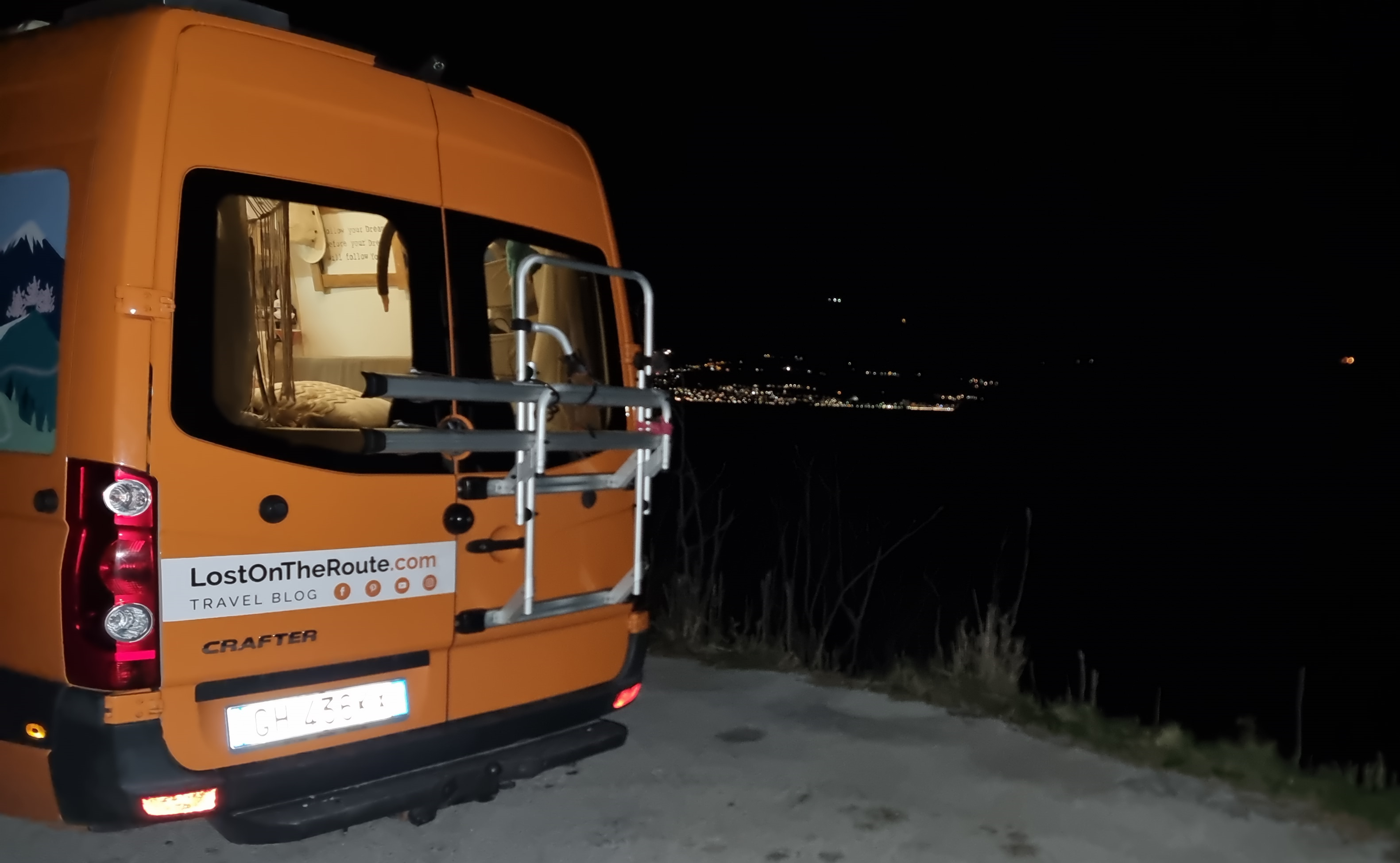
Before going full-time, I had bought a kit of plasters and bandages for emergencies on Amazon.
We never opened it in two years… but we found ourselves spending hours looking for pharmacies time and time again!
Once in Arles (France), Isa started feeling very sick, and we searched the whole town to buy a thermometer!
In Torrox, Spain, Isa was bitten by a tiger mosquito, and we had to go get some ointment.
Another time, passing near Turin, Isa’s gum suddenly swelled up and turned all black, and we started looking for a night-time pharmacy at 11 pm to find an antibiotic.
And like these, there are many other stories (almost always about my dear Isa – poor girl, who attracts misfortunes :'( ).
The moral of the story? Now we keep a comprehensive first aid kit for every eventuality: we’re a small mobile pharmacy now!
TIPS TO MAKE A COMPLETE FIRST AID KIT
It’s vital to keep a well-stocked first aid kit on hand.
What does well-stocked mean? Think beyond just bandages.
Your kit should include:
- antiseptics: for disinfecting hands or objects,
- antibiotics: for bacterial infections,
- gauze: for light wounds/pains
- adhesive tape,
- pain relievers: Oki, Fastumgel and the like… all for sudden pain relief.
- scissors
- Plasters, thermometer and an Ice Pack: for the most common occurrences
I know it might feel over-prepared, but if any injuries pop up, you’ll be thanking your past self for thinking ahead!
Last but not least, in addition to the first aid kit, it’s important to have an emergency plan too: always have a plan for the worst-case scenario!
That means knowing the emergency numbers in the country you’re travelling to, having an offline or physical map just in case your GPS fails you, preparing a procedure on how to act if something bad happens… Out there in the wild (or even in the next small town over), a solid emergency plan is your best friend!
Mistake 6:
Overestimating your Vehicle Capabilities
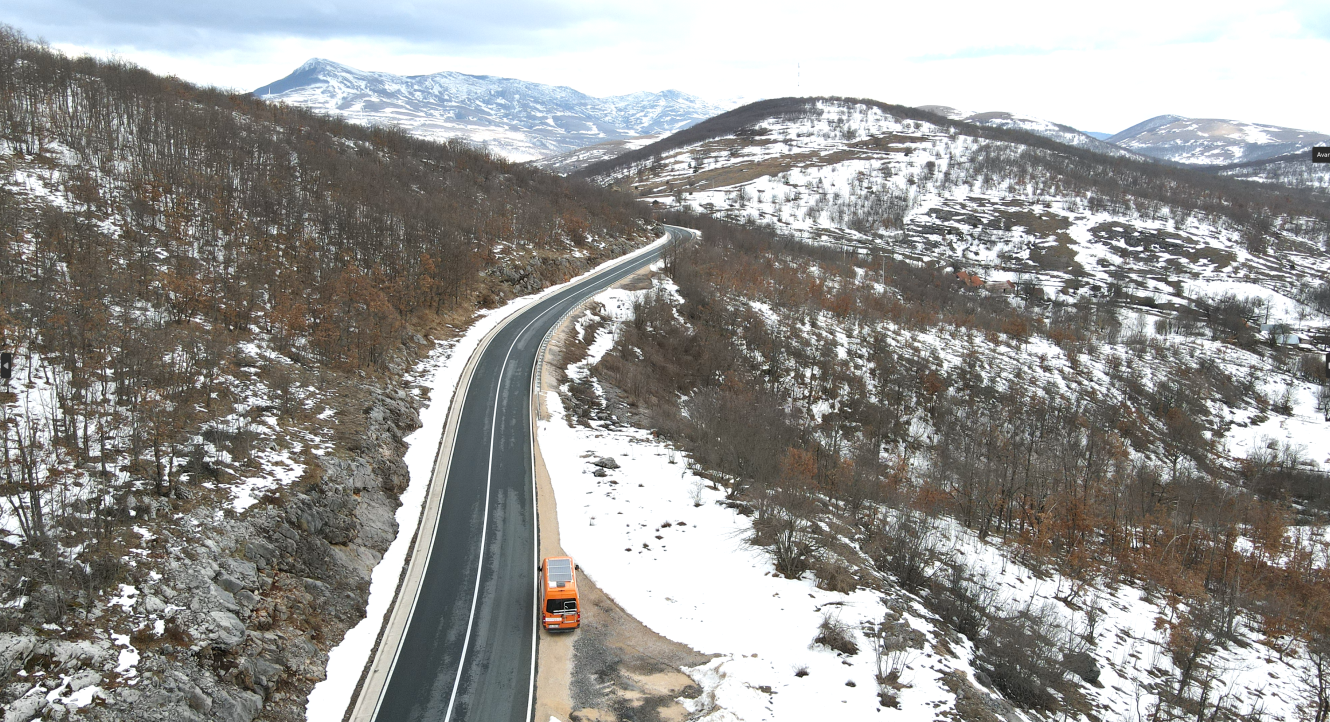
We built our campervan starting from a commercial van.
We chose a van instead of a classic camper, not only because of the price (cheaper at that time!) but also because it isn’t like driving a standard RV or motorhome: vans are more agile, bouncier, and more maneuverable.
At the same time though, driving a van isn’t quite like driving an off-road vehicle either: every pothole in the road shakes everything in the cabinets, the clearance is still low and can scrape on dips (especially with a long wheelbase), the vehicle’s weight is significant, etc.
We tend to imagine that our RV or van can reach any place, until we discover the hard way one day, that they can’t!
Overestimating your vehicle doesn’t help keep it in good shape for long.
Pushing the engine of campers over 3.5T at speeds above 130km/h is madness.
Once we were on a rush (happens rarely but it happens!) and we went faster than that.
The karma cause one of our wheels to explode (without consequences luckely, except arriving even later!).
Taking RVs/vans too quickly on mountain roads is just as bad: for the suspensions is bad, for our stored objects that might crash (our TV smashed against the wall few times while we were crossing mountains in Greece, leaving good marks on the wall!), and there’s also a risk of getting scratches from branches.
Last but not least, when we’re driving in mud, snow, sand…without the right setup and accessories, campers can easily get stuck, and boy, are they heavy to pull out!
TIPS TO DRIVE SAFELY:
Understand the limit of your vehicle, and respect it
Mistake 7:
Skipping the Regular Maintenance
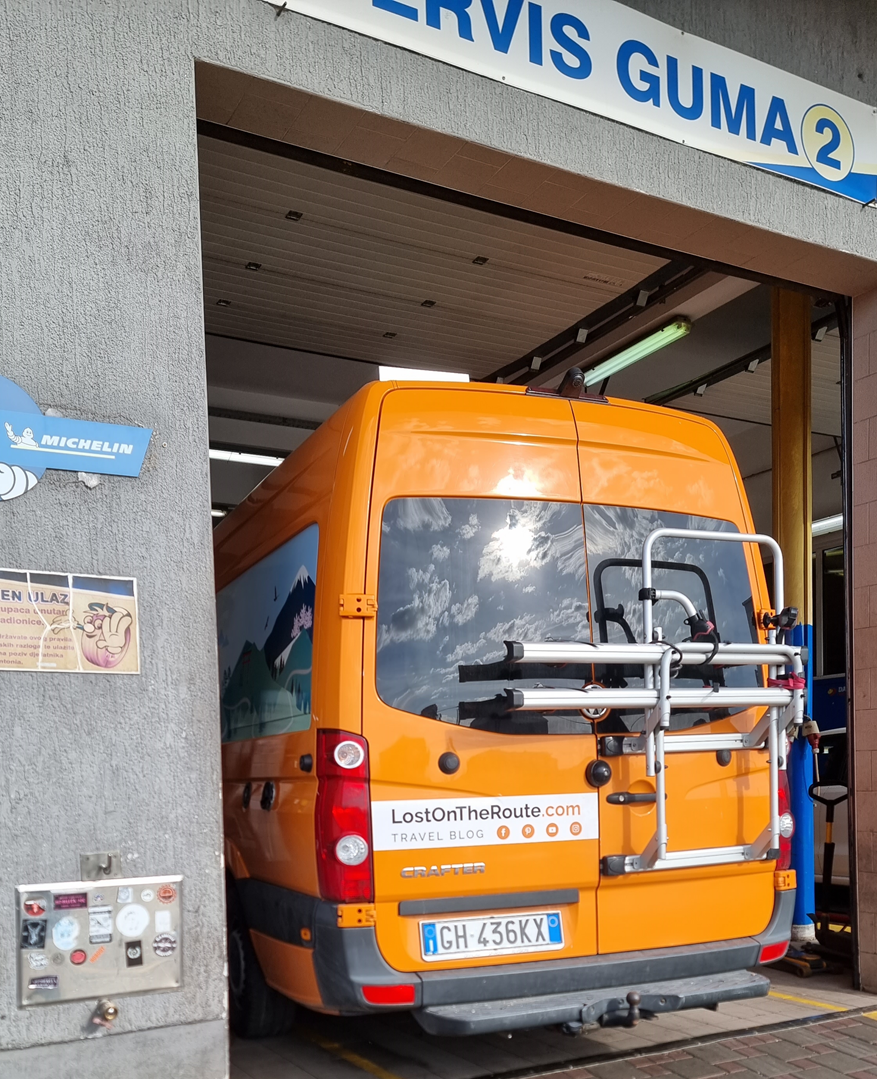
Maintenance, maintenance, and more maintenance.
Keeping up with a camper typically costs more than maintaining a car.
It’s not just the mechanical parts that need attention, but also the living side and all its systems: batteries, plumbing, solar panels, heating, fridge, ventilation, shower tray…
Neglecting even one of these key aspects could lead to unpleasant surprises in the long run.
Personally, I’m a maintenance fanatic, and at least 3-4 times a year (about every quarter), I get couple of days to work extensively on our van to keep it clean, efficient, and functional.
Of course, at the beginning I also didn’t know a thing and overlooked some procedures!
Then while traveling, performing maintenance, and interacting with many camper enthusiasts over the years, I’ve discovered many little tricks to improve my routine checks and many products i totally ignored to help keep our camper in top shape.
Below, I’ll leave you my very own comprehensive list 🙂
TIPS TO MAKE GOOD MAINTENANCE:
- Address Issues Promptly: If you hear an odd noise or something feels off, don’t ignore it. Small problems can escalate into bigger issues, like a minor leak leading to significant water damage. Take the time to deal with any irregularities as soon as they arise to keep your campervan trip on track.
- Keep the van free of dust: in such a small space, the dust can easily be sucked by the heating and sent flying in your living area.
- Clean the Ceiling Vent Regularly: especially in the good season, the faster the vent, the more mosquitos get smashed by it! What it means is: blood, blood and more blood. While one mosquito you won’t even notice it, in couple of months the vent will start changing colors and get sticky too! Dismounting it regularly and rinsing it thoroughly is essential to keep it clean and performing well in the long run!
- Change the Anti-bacteria in the water tanks: choose dark tanks to avoid light getting in. If you don’t use your tanks for long times, empty them. If you keep water in your tank, be sure to use an anti-bacteria to avoid the proliferation of Algae or other waterborn bacterias.
- Clean at least once a year the grey-water tank inside out: that’s something that most campervan travelers skip. We also didn’t clean it throughly for more than a years. We remembered to clean it when it started smelling horribly, and when the grey waters started smelling like black waters! For maintenance, we suggest to pour in the tank 10 liters of bleach, and take the van for a ride: it works like miracle! Alternatively, there’s the old fashioned-way of removing the tank and clean it by hand… but it’s not always easy on the road nor convenient.
- Every couple of months make a routine check for humity and mold: making a routine check means having time to act before things get our of hand! During our first winter, we noticed that our front cabinet was getting wet during the night (it’s the point we insulated less!), and few dots of mold started to grow. As soon as we noticed, after freaking out, we learned about mold and how to deal with it! We first wiped the area with a mold remover, then we treated our full van (all of it, not just the area!) with a bio-active paint, and then we got a dehumidifier that we use to keep our van humidity in check around 50% (we got a termometer/hygrometer too to check it too!). We never found mold again in the past year and half 🙂
- Check regularly water and heating pipes: pipes, if well installed, should be eternal. Said that, because a campervan is constantly moving, it’s possible that pipes might move or get damages in the long run. Giving a visual check now and then is always a good way to prevent future problems!
- Don’t ignore yellow warning lights for too long: on the dashboard, the color “yellow” is a signal that something is not right, but also that it’s not a danger for your drive: YET! Be sure to check out the signaled issues before the warning light turns red, as that can truly damage your vehicle and cost you lot of money in repairings!
- Go immediately to a mechanic if you get any red warning light: no panic, but go to the closer one you can find – it means that your camper has a mechanical problem that needs urgent fixing.
- Write down the dates when you change components: so you can keep track of their useful lifetime!
- Check Tire pressure and tread regularly: I know I already said it before, but better twice than never. The tyres health is essential for a safe and comfortable trip, so keep it always in mind!
- Ensure all lights and signals are functional: modern vehicles signal you a faulty light on the dashboard, but older ones don’t. Be sure to check all your lights from time to time and if one is broken, change it! It’s for your safety after all! (We always keep some spare light bulbs in our van for not having to look for them on the road – they’re so cheap anyway!)
- Check oil levels and other fluid: said before, I repeat this one here too: oil, diesel, brake fluid, AdBlue, windscreen fluid… be sure to check them regularly to avoid remaining without when you need them most!
Mistake 8:
Overtrusting your Navigation App
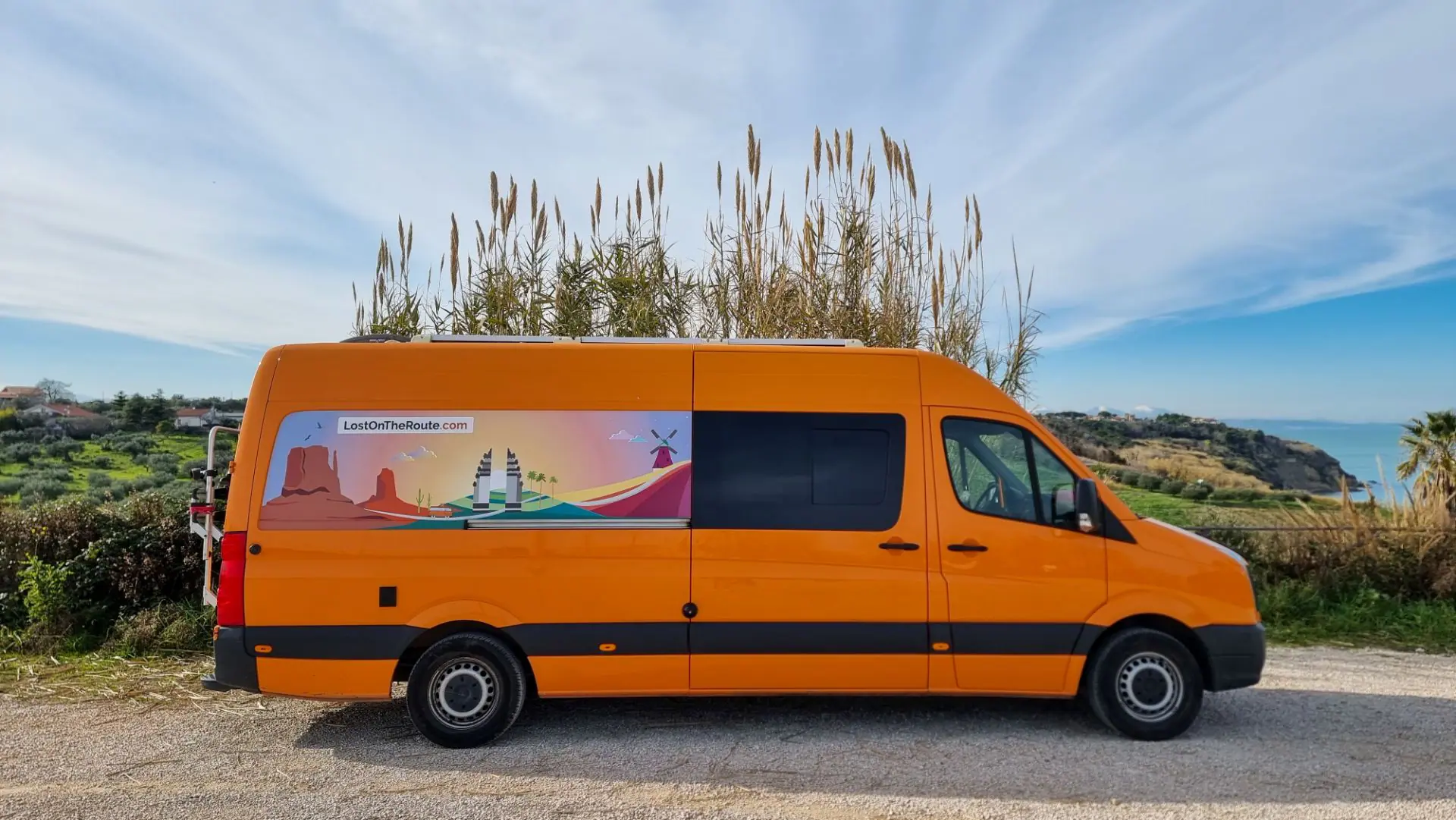
Google Maps is a fantastic app, but it’s important to understand both how it works and accept its limits.
The same goes for many other navigation apps: Waze, Sygic, Trucklords etc… all apps have limits!
OUR WORST NIGHTMARE: AN UNWANTED DETOUR ON A MOUNTAIN
During our first trip to the French Riviera, I set the destination to “Nice” on the Waze app, avoiding tolls (we almost always take the regular roads to see the landscapes).
Following the app, we ended up on a mountain road that kept going up and up, getting narrower and narrower, with no possibility to turn our 7-meter van around.
At one point, passed the village of Gorbio, the road turned into a dirt track, and it was really very narrow.
We barely fit, but since we couldn’t turn around, we decided to keep going.
Eventually, we arrived at the top of the mountain above Nice and Monaco, a spectacular place…but not suitable for a van like ours.
To go down, there was only one way (the one to go up was one-way).
The slope was more than 20%, practically vertical!
The turns were also tight, and occasionally we had to do two or three maneuvers to turn around, reversing uphill at crazy slopes…. at the time, I was literally scared out of my wits, and after cursing Waze in every possible language, I uninstalled it.
TIPS TO IMPROVE YOUR NAVIGATION
To avoid finding yourself in situation like the one described before (and believe me when I say it was not the only one nor the worst!), keep your GPS updated and have a physical map in hand, especially in areas where signal might be weak or non-existent.
On top of that, we would recommend you to:
- Pre-load your destination and way points: to avoid getting lost.
- Review your route manually for potential challenges: like narrow lanes or low-clearance bridges that could end up damaging your rig.
- If you’re in doubt, use Google Map in 3D: we live in the future, so you can actually “see” the road before going there
- Don’t always trust Google Maps: check the map yourselves and see alternative routes (for saving a few minutes, Google might bring you to awful dirt roads and send you on mount Everest and back!!)
- Choose a navigation app especially designed for campervans: Copilot, Sygic, Igo, Truck Navigation…there are many apps out there designed for campervans, some free and some premium. You insert the dimensions of your vehicle, and the app will give you roads that you can traverse (most of the times at least!). Be sure to check out also our article 15 Useful Apps for a Campervan Trip 🙂
Mistake 9:
Not Booking Campgrounds and Activities in Advance
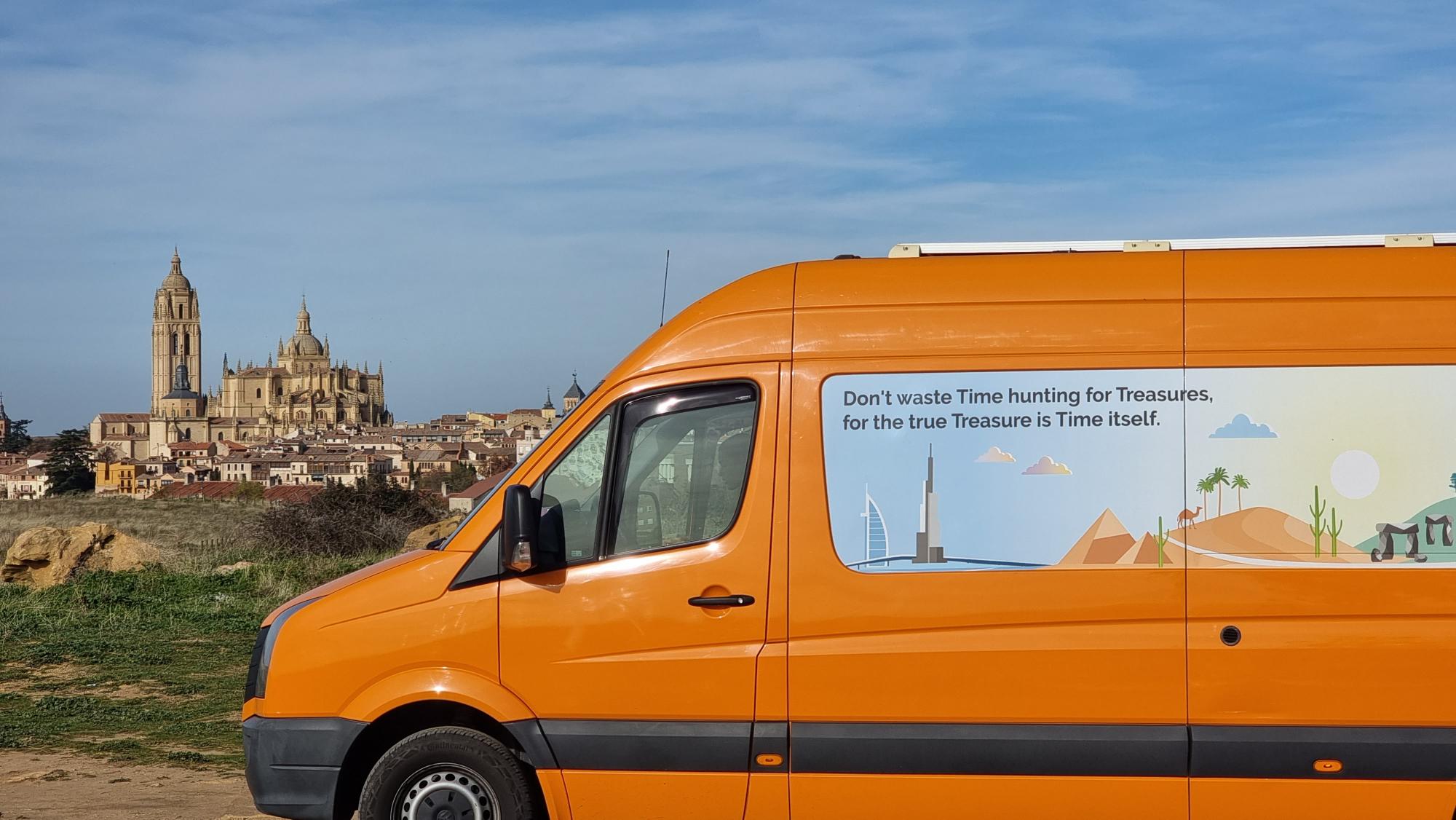
We like planning our trips “on-the-go” and often parking freely, we’re not the kind of people that makes reservations in advance.
Yes, if we find something interesting in a place we plan to visit, we might look it up a day before, or two at the most.
For us, not planning means feeling free to manage our time without deadlines… but at the same time, it sometimes has its downsides, and we’ve realized this through traveling and learning from our mistakes!
Some of them, might be unable to visit very popular attractions: on our journey through Spain for example, we weren’t able to visit the Alhambra in Granada or the Picasso Museum in Malaga because tickets were selling weeks in advance.
We don’t normally make use of campings, but we had our experience of “crowds” while looking for a water source during easter on Lake Garda: everywhere, was full.
In many campings they would not even make you fill your water tank, because there was no place to turn: so overcrowded!
If you plan to visit campsites during the high season, be sure to reserve in advane to avoid surprises; while if you need a campsite in low season, be sure to call in advance to check if they’re even open!
RECAP TO AVOID BAD SURPRISES:
- Check out in advance the attractions you’re want to visit
- Book tickets in advance
- Book campings in advance if you’re traveling in high season
- Call campings in advance if you’re traveling in the low season
- Have a backup plan for boondocking spots in case of closures or restrictions.
Mistake 10:
Not having a Flexible Attitude
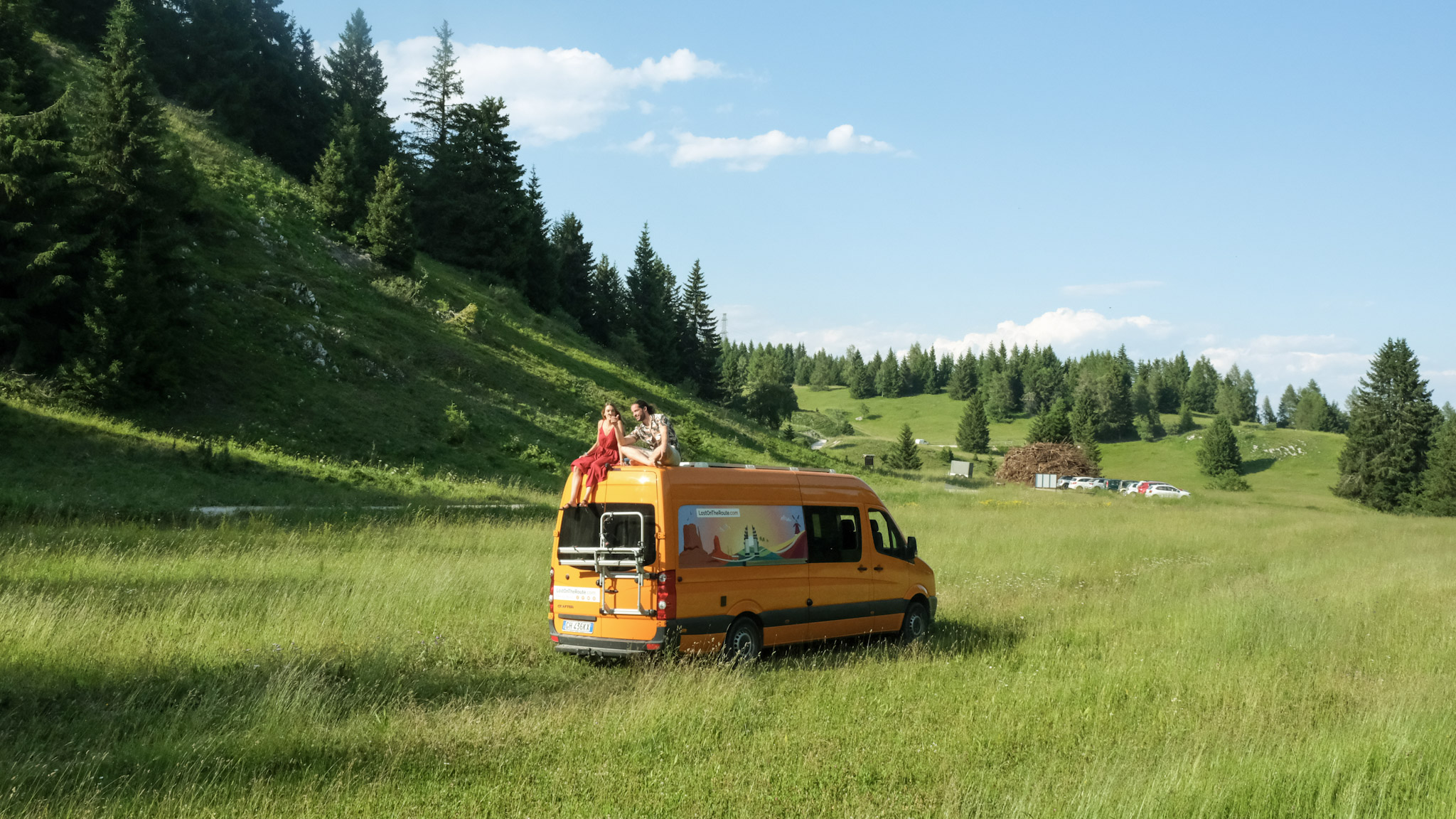
Despite our initial lack of extensive van life experience and preparation when we started, there was at least one thing on which we were ready: our mindset!
We knew that leaving everything behind to travel full-time in a converted van was a leap into the unknown.
We expected the unexpected, we saw the mishaps coming!
We were aware that it wouldn’t all be roses and sunshine, as those viewing this lifestyle from the outside might imagine… and being mentally prepared and flexible is what helped us handle everything calmly and put our misadventures into perspective!
With the right state of mind, we were able to “enjoy” in some way the bumps in the road and to see them as mere stepping stones of our journey.
We didn’t panic (at least not excessively ahah), we didn’t lose our morale, and we even find courage to write this article and tell you ironically about all our misfortunes!
Traveling in a camper is wonderful, despite anything that might happen along the way.
Yes, there can be mistakes and problems along the way, but every misadventure also contributes to growing our knowledge and resilience to hit the road every time more prepared!
Weighing all our mishaps on one side, against all the epic moments we’ve experienced thanks to the camper, the views, the sunsets, and the sense of freedom on the other… well, the mishaps are catapulted away!
Conclusion
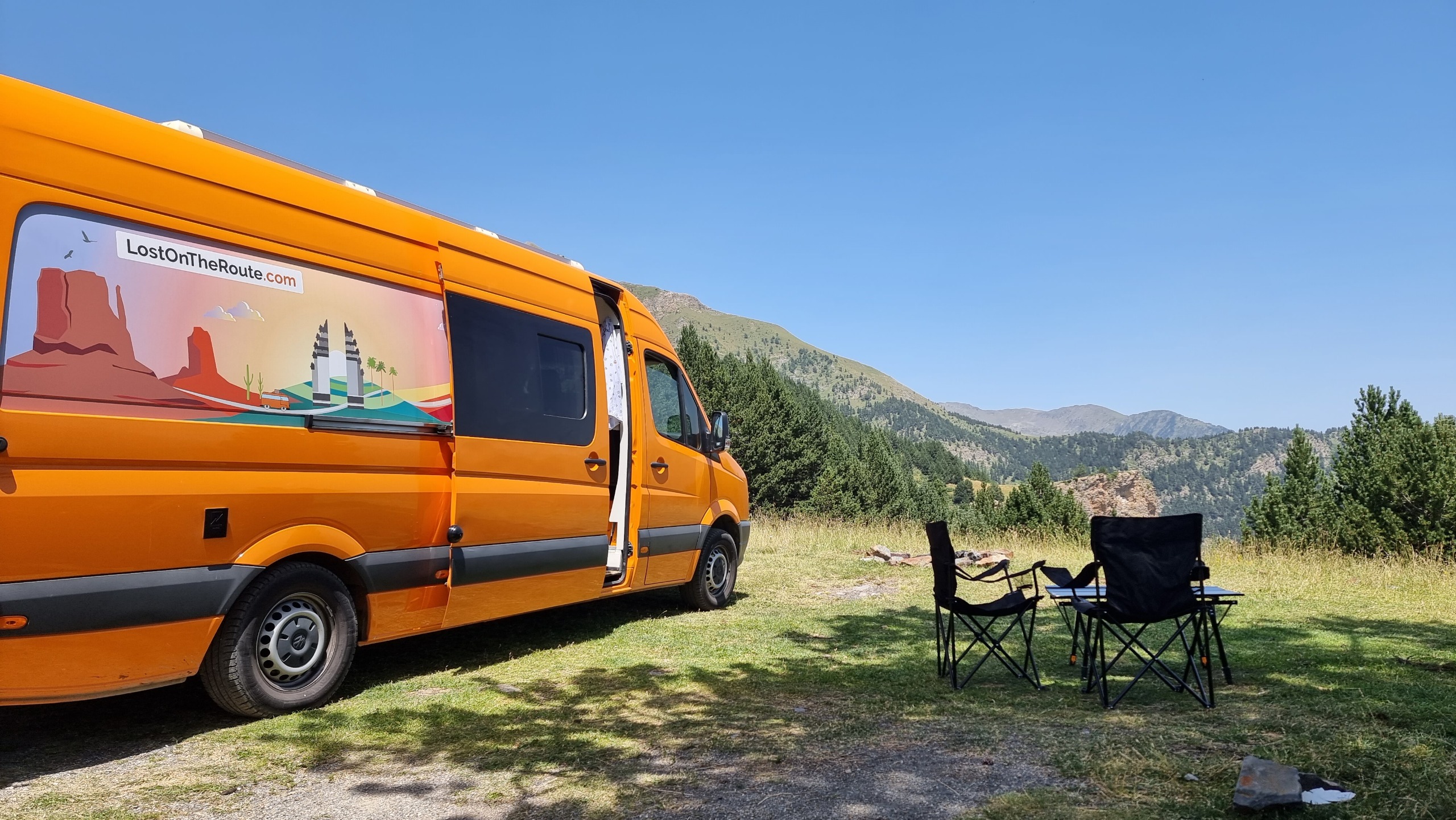
And here we are at the end of the article! 🙂
In this post, we opened up and revealed you all of the most stupid mistakes we made on our first two years living in van!
Hopefully, with our tips, you’ll be able to enjoy your adventures in a much more prepared and relaxed way! 😀
Before going I would like to ask you:
- Was the read useful to you?
- What was your the worst misadventure you lived with your camoer? 🙂
- Do you have any tip that might be added to this list?
LET US KNOW IN THE COMMENTS BELOW!
We always love receiving feedback and exchanging a chat 🙂
As always, thank you for reading,
And see you in the next article! 😀
PRIMA DI ANDARTENE, POSSO CHIEDERTI UN FEEDBACK?
Scrivere articoli dettagliati come questo richiede molto tempo ed impegno.
Se ti è piaciuto, posso chiederti di lasciarmi un messaggio di feedback nei commenti a fondo pagina?
Per un content-creator, sapere di essere letti e che i tuoi sforzi sono utili a qualcuno, è la miglior motivazione per continuare a scrivere e a fare meglio 🙂
Fammi sapere cosa ti è piaciuto o cosa secondo te si potrebbe aggiungere.
Se ti va, puoi anche condividere l’articolo per aiutare altra gente a trovarlo!
Grazie per l’aiuto 🙂

Leggi le Guide per Camperizzare il tuo Furgone Fai-da-Te
The Best Beaches in Puglia and How to Get There
Every region of Italy is special in its way, and Puglia is no exception! Assaulted by Italians in summer, and increasingly discovered by more and more international tourists every year, this southern region has a lot more to offer than what meets the eye! To name a...
TOP 11 Places for Hot Air Balloon Rides Around the World
Only a few things can compete with a hot air balloon ride when it comes to a breathtaking, memorable and unforgettable experience! Floating in the sky light as a feather, taking panoramic views of magnificent landscapes and feeling the gentle breeze on your face is a...
Discover the Wonder of Amazon Plants on an Amazon River Cruise
The Amazon rainforest is one of the most biodiverse regions on Earth, and the Peruvian Amazon is no exception. It is home to an incredible array of exotic plants that captivate the imagination and leave visitors in awe. In this article, we will explore some of the...
Visit the Last Supper in Milan | Tickets and Free Pocket Guide!
The Last Supper, painted by Leonardo da Vinci between 1495 and 1498, is one of the most famous and revered artworks in history! After all, who never saw it on school's books, in popular movies or revisited more recently as an internet meme? I guess, nobody older than...
Conero Riviera | The Most Beautiful Beaches | Discover What To See
The Conero Riviera in Italy is an incredible touristic destination that attracts more and more visitors every year, thanks to its unique views, crystal clear water, hospitality, and good food. After visiting and seeing it with our own eyes, we can only confirm what...
Conero Riviera | The Most Beautiful Beaches | Discover What To See
Trabocchi Coast in Abruzzo: All The Most Stunning Beaches!
"Stretched from the rocks, Similar to a lurking monster, With its hundred limbs, the trabocco looked formidable." - GABRIELE D'ANNUNZIO (Italian Poet) TRABOCCHI COAST: WHICH ARE THE MOST BEAUTIFUL BEACHES? The Trabocchi coast, which stretches between...
Madonna della Corona, Italy: Discover the Magical Church on the Mountain
Not far from Verona and the eastern coast of Lake Garda, hides the sanctuary Madonna della Corona, an incredible place that appears straight out of a fairy tale: a church on the mountain set in the rock above a very high cliff! In this guide, I want to tell you how to...
The Bauxite Quarry | Discover the Martian Pond near Otranto, Italy
Today I'm going to tell you about a place we discovered a bit by accident while driving on the coast of Apulia: the Bauxite Quarry! You're probably already wondering what it is, as we also did when we first heard of it! Let's say it's really an experiencefrom another...
Lago di Braies: How to Visit the Pearl of the Alps
Where Is Lago di Braies? Lago di Braies, also called "Lake Braies" in English or "Pragser Wildsee" in German, is an alpine lake located between the Dolomites of South Tyrol (in Italy) and not far away from the Austrian border. Content Summary Famous for its...
Lake Tovel: Where Is It and Everything you Need to Know
Where Is Lago di Tovel? Lago di Tovel (also referred to as Lake Tovel in English) is one of the most charming alpine lakes of the Dolomites and it is located within the Adamello Brenta Natural Park in Trentino, Italy. Content Summary Lake Tovel got famous...
Visit Matera in Italy: The Magical City of Stone
Where Is Matera? Matera, also known as the "City of Stone", is located in the Southern Part of Italy, in the Region of Basilicata. The city, until a few decades ago one of the poorest areas in Italy, has seen in recent years a surge in popularity that brought it...

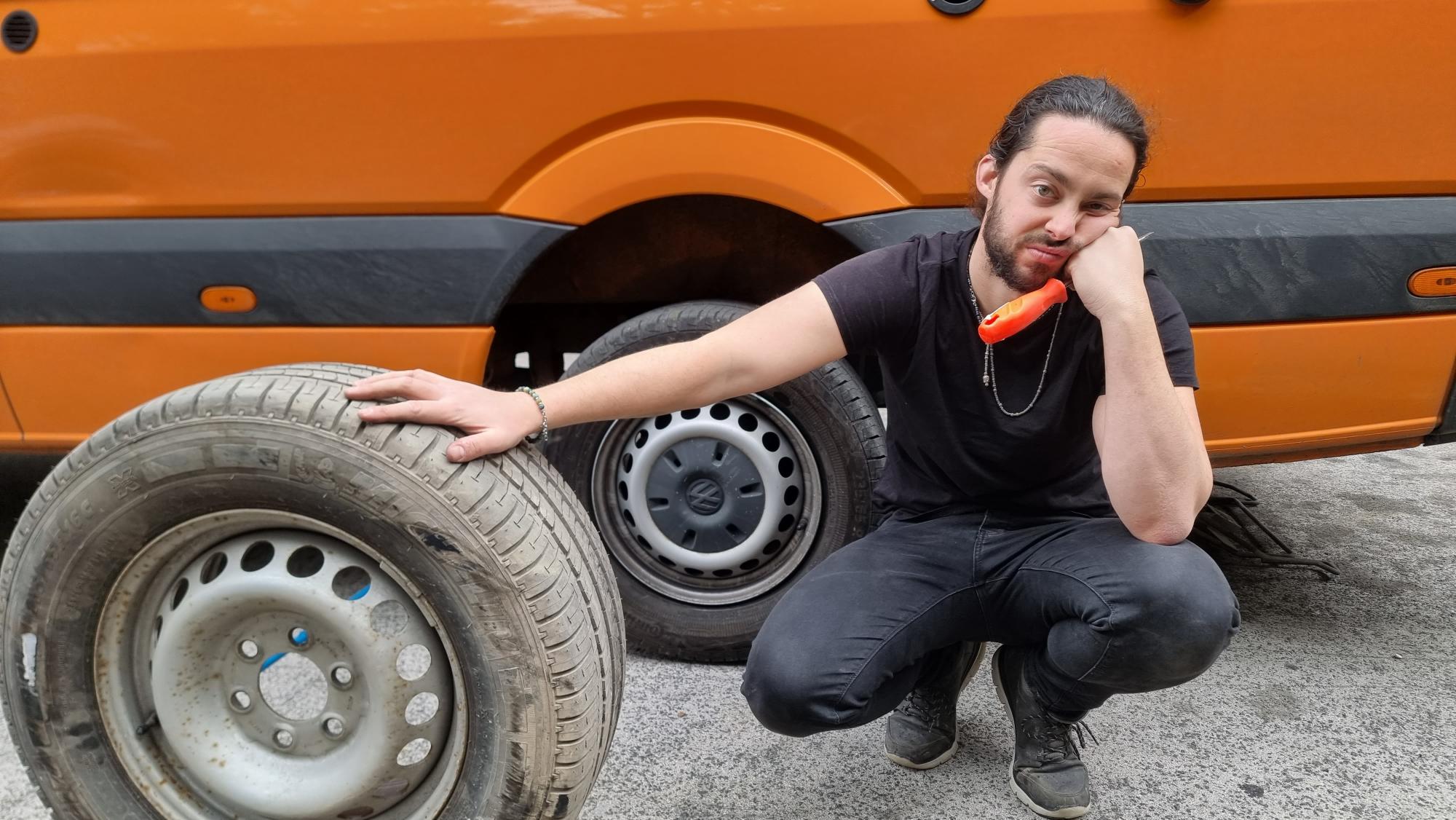
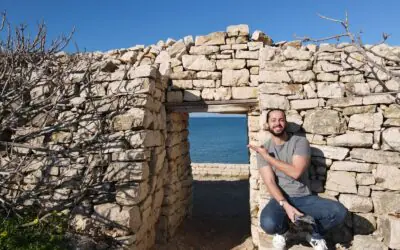
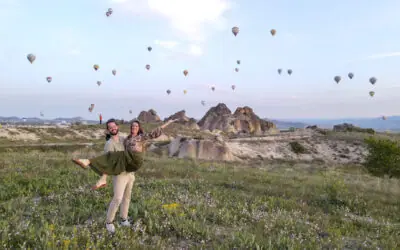
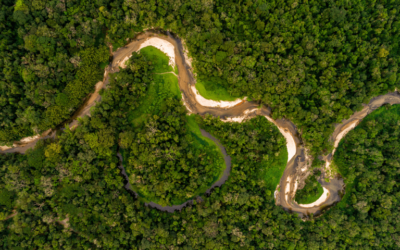

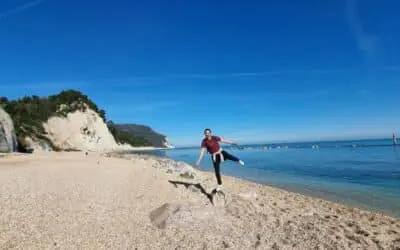
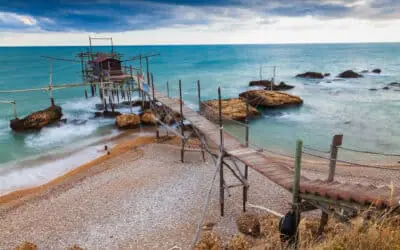
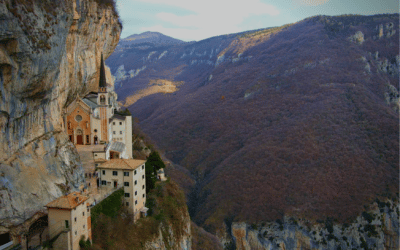
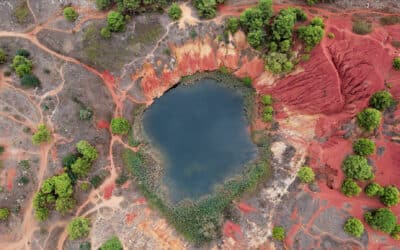
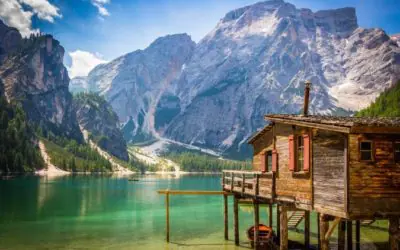
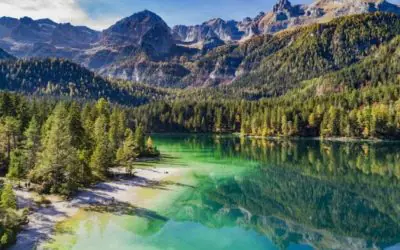
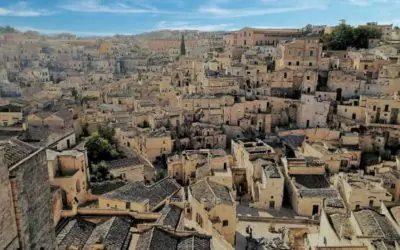
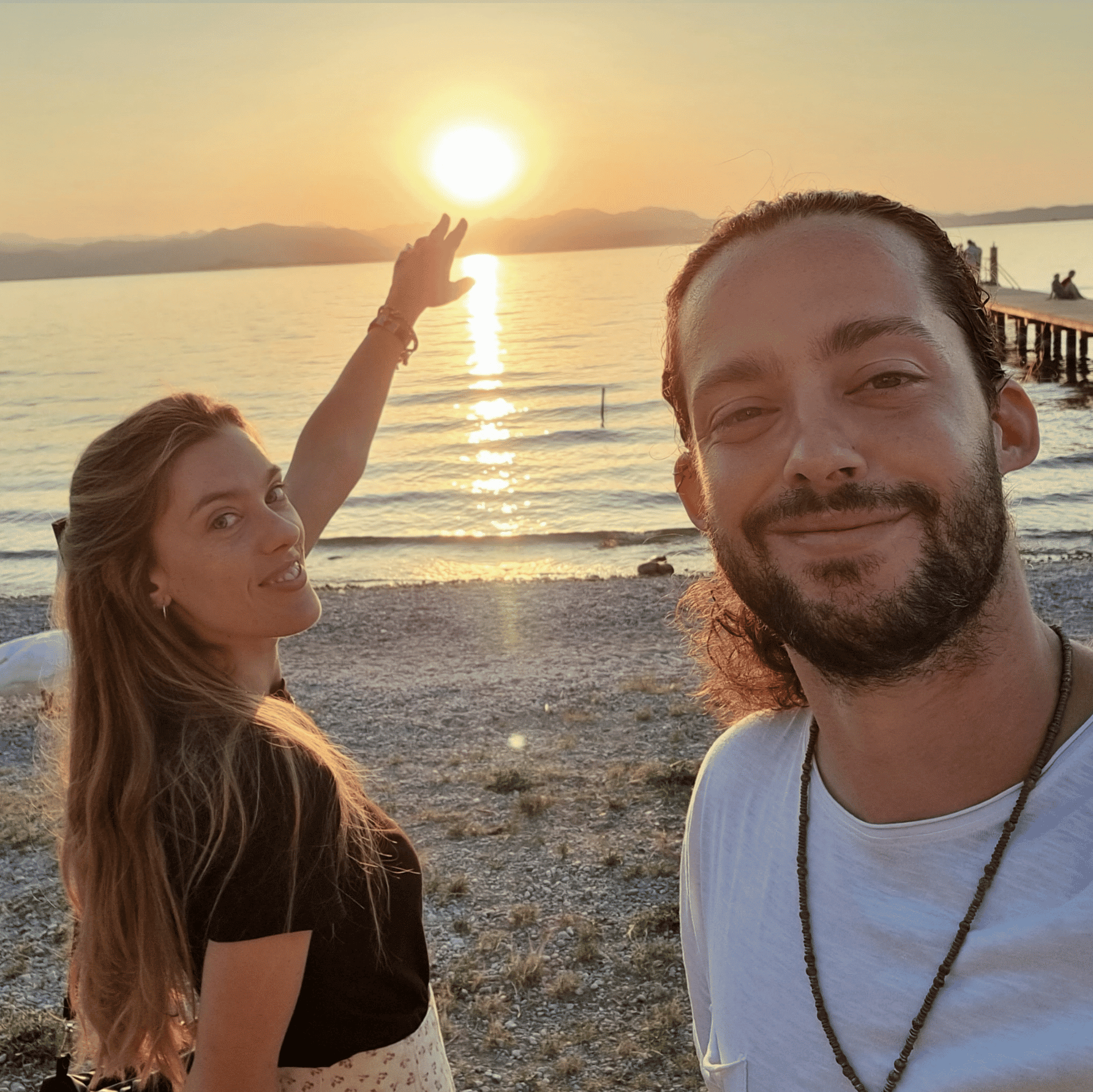


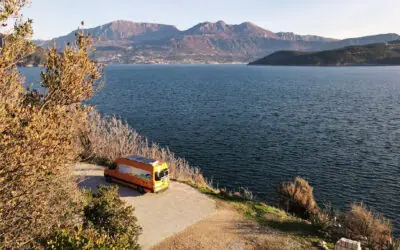
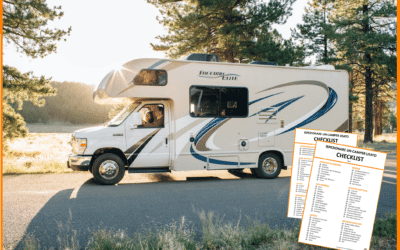
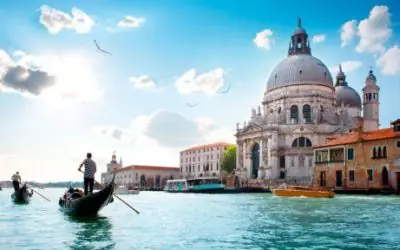

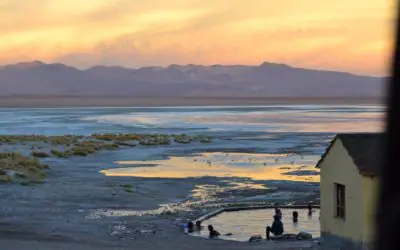
0 Comments